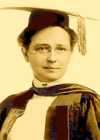Emilie Martin
Emilie Norton Martin (30 December 1869, in Elizabeth, New Jersey – 8 February 1936)[1] was an American mathematician and professor of mathematics at Mount Holyoke College.[2]
Emilie Martin | |
|---|---|
 Emilie Norton Martin | |
| Born | December 30, 1869 Elizabeth, New Jersey |
| Died | February 8, 1936 (aged 66) South Hadley, Massachusetts |
| Nationality | American |
| Alma mater | Bryn Mawr College |
| Scientific career | |
| Fields | Mathematics |
| Institutions | Mount Holyoke College |
| Thesis | Determination of the Non-Primitive Substitution Groups of Degree Fifteen and the Primitive Substitution Groups of Degree Eighteen (1901) |
| Doctoral advisor | Charlotte Scott James Harkness |
Life
Martin earned her bachelor's degree at Bryn Mawr College in 1894 majoring in mathematics and Latin. She continued her graduate studies at Bryn Mawr under the supervision of Charlotte Scott.[3] In 1897-1898 she used a Mary E. Garrett Fellowship from Bryn Mawr to study at the University of Göttingen.[3] In Göttingen, Martin and Virginia Ragsdale attended lectures by Felix Klein and David Hilbert.[4] Although her name and dissertation title were printed in the 1899 commencement program, her Ph.D. wasn't granted until 1901 when her dissertation was published.[4]
In 1903 she became an instructor at Mount Holyoke College. She was later promoted to associate professor and then professor. Although she had earned a doctorate, it did not hasten her promotion to professor. She spent eight years as an instructor and fifteen as an associate professor. This was common for women of her time, who were often unable to pass the associate professorship. Martin's research focused on primitive substitution groups of degree 15 and primitive substitution groups of degree 18. In 1904 she published the index to the first ten volumes of the Bulletin of the American Mathematical Society.[2]
Martin was a member of the American Association for the Advancement of Science, the American Mathematical Society, and the Mathematical Association of America.[2]
References
- Ogilvie, Marilyn; Harvey, Joy; Rossiter, Margaret, eds. (2014) [2000]. The Biographical Dictionary of Women in Science: Pioneering Lives From Ancient Times to the Mid-20th Century. Routledge. p. 848. ISBN 978-1-135-96343-9.
- Bailey, Martha J. (1994). American Women in Science: A Biographical Dictionary (second ed.). ABC-CLIO. pp. 236–237. ISBN 978-0-87436-740-9: Profiles 400 women who lived or started their careers before 1950
- Riddle, Larry. "Emilie Norton Martin". Biographies of Women in Mathematics. Anges Scott College.
- Green, Judy; LaDuke, Jeanne (2009). Pioneering Women in American Mathematics: The Pre-1940 PhD's. American Mathematical Soc. p. 235. ISBN 978-0-8218-9674-7. Biography on p.385-387 of the Supplementary Material at AMS
External links
- Emilie Martin on the Mathematics Genealogy Project
- Relating To Required Mathematics For Women Students by Emilie Martin for the American Mathematical Monthly